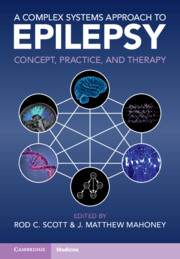Book contents
- A Complex Systems Approach to Epilepsy
- A Complex Systems Approach to Epilepsy
- Copyright page
- Contents
- Contributors
- Chapter 1 Introduction
- Chapter 2 Systems Biology Approaches to the Genetic Complexity of Epilepsy
- Chapter 3 Transcriptomic and Epigenomic Approaches for Epilepsy
- Chapter 4 Phenomenological Mesoscopic Models for Seizure Activity
- Chapter 5 Personalized Network Modeling in Epilepsy
- Chapter 6 The Baseline and Epileptiform EEG
- Chapter 7 Neuronal Approaches to Epilepsy
- Chapter 8 Mapping Epileptic Networks with Scalp and Invasive EEG
- Chapter 9 A Neuroimaging Network-Level Approach to Drug-Resistant Epilepsy
- Chapter 10 Epilepsy as a Complex Network Disorder
- Index
- References
Chapter 4 - Phenomenological Mesoscopic Models for Seizure Activity
Published online by Cambridge University Press: 06 January 2023
- A Complex Systems Approach to Epilepsy
- A Complex Systems Approach to Epilepsy
- Copyright page
- Contents
- Contributors
- Chapter 1 Introduction
- Chapter 2 Systems Biology Approaches to the Genetic Complexity of Epilepsy
- Chapter 3 Transcriptomic and Epigenomic Approaches for Epilepsy
- Chapter 4 Phenomenological Mesoscopic Models for Seizure Activity
- Chapter 5 Personalized Network Modeling in Epilepsy
- Chapter 6 The Baseline and Epileptiform EEG
- Chapter 7 Neuronal Approaches to Epilepsy
- Chapter 8 Mapping Epileptic Networks with Scalp and Invasive EEG
- Chapter 9 A Neuroimaging Network-Level Approach to Drug-Resistant Epilepsy
- Chapter 10 Epilepsy as a Complex Network Disorder
- Index
- References
Summary
Epilepsy is the most common of the chronic and severe neurological diseases. It affects 65 million people worldwide and is characterized by an augmented susceptibility to seizures. Seizures are “transient occurrence of signs and/or symptoms due to abnormal excessive or synchronous neuronal activity in the brain” [1]. Current therapeutic strategies have the goal of suppressing or reducing the occurrence of seizures, thus being symptomatic rather than curative. There are no known therapies able to modify the evolution of acquired epilepsy, or to prevent its development. Furthermore, 25–40% of patients do not respond to pharmacological treatment, and this number stays unchanged when using new generation antiepileptic drugs as compared to established ones. For drug-resistant patients with focal epilepsy (an epilepsy in which seizures start in one hemisphere) there exists an alternative to medication: surgical resection of the brain regions involved in the generation of seizures, the epileptogenic zone, under the constraints of limiting post-surgical neurological impairments. Rates of success of brain surgery for epilepsy treatment vary between 34% and 74% as a function of the type of epilepsy. Outcomes are very variable, depend on the patient condition, and can change in time.
- Type
- Chapter
- Information
- A Complex Systems Approach to EpilepsyConcept, Practice, and Therapy, pp. 41 - 60Publisher: Cambridge University PressPrint publication year: 2023
References
- 1
- Cited by



